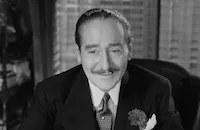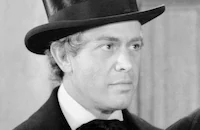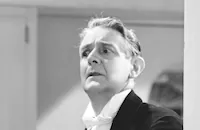The Worst Woman in Paris?
Cast & Crew
Monta Bell
Benita Hume
Adolphe Menjou
Harvey Stephens
Helen Chandler
Margaret Seddon
Film Details
Technical Specs

Synopsis
Beautiful Englishwoman Peggy Vane tires of being gossiped about in Paris, where scandalmongers have labeled her "the worst woman in Paris" because of her numerous suitors. Her constant companion is the wealthy and jaded Adolphe Ballou, who is known as "the best-dressed man in Paris." The two sophisticates grow weary of their daily routine and assume that they are bored with each other. They agree to part company, and after Adolphe promises her that he will always stand by her if she needs him, Peggy goes to America with her maid Jeanine. In Bridgetown, Kansas, the train Peggy and Jeanine are on is involved in a wreck, and inspired by the courage of John Strong as he rescues trapped passengers, Peggy saves a baby and is injured in the process. While Bridgetown citizens are acclaiming her heroism, Peggy convalesces in the home of John and his mother, who are the kind of simple people Peggy once admired but now regards as amusing. As the days pass, Peggy loses her veneer of over-sophistication and grows to respect Mrs. Strong and John, who is the headmaster of a boys school. Although John is blind to it, Peggy notices that his loyal secretary, Mary Dunbar, is in love with him. John is awestruck by Peggy's glamor, however, and his sweet attentions begin to wear down her resistance. She encourages him to accept the job of president of the state university, which he had intended to turn down despite Mary's insistence that he could handle the job. Believing that moving to a bigger city will entice Peggy to stay with him, he accepts the position and dreams of marrying her. Peggy has similar dreams but soon realizes that her reputation will ruin John's career. The night after Peggy makes up her mind to leave, Jeanine shows her a Paris newspaper article about Adolphe, who has lost his fortune and is now a clerk in the company he once owned. When John asks her to marry him, Peggy tells him that she cannot because she must return to the man who gave her everything. John is crushed by Peggy's pretense of coldness and goes to the school, where he tells Mary that he will not be taking the university job. Caring only for John's welfare, Mary begs Peggy to help him, and Peggy, impressed by the depth of Mary's love, goes to see John. She confesses that she loves him and asks him to make their goodbye something wonderful. The next morning, Mrs. Strong tells Mary that she is worried about John, for he did not come home the night before, and about Peggy, who did not return until very late. The mayor arrives to thank Peggy for rescuing the child, after which Peggy bids a bittersweet farewell to Mrs. Strong and Mary and returns to Paris. There she finds Adolphe and gives him her jewels to pay off his debts. Realizing that they belong together, the couple are married and learn to ignore the gossips who insist that Peggy only returned to Adolphe to help him spend his regained fortune.

Director

Monta Bell
Cast

Benita Hume

Adolphe Menjou

Harvey Stephens

Helen Chandler
Margaret Seddon
Adele St. Maur

Leonard Carey
Maidel Turner

George Irving
Crew
Monta Bell
Monta Bell
Martin Brown
Robert Burkhardt
S. C. Chapman
Louis De Francesco
Marion Dix
Rita Kaufman
Arthur Lange
Jesse L. Lasky
Paul Lockwood
Hal Mohr
Emmet O'brien
Max Parker
Irving Rosenberg
Les Selander
William Skall
Robert Surtees
Anthony Ugrin
A. L. Von Kirbach
Paul Weatherwax

Film Details
Technical Specs

Quotes
Trivia
Notes
Variety reported that producer Jesse L. Lasky first attempted to borrow Jean Harlow from M-G-M for the lead, and then Claudette Colbert from Paramount when M-G-M turned down his request. According to Hollywood Reporter and Film Daily news items, Myrna Loy was signed to play "Peggy Vane," and when she was forced to relinquish the role due to poor health, she was to be replaced by Carole Lombard. Motion Picture Daily reported that Lasky then tested Tallulah Bankhead, Ina Claire, Zita Johann and Sally Eilers before selecting Benita Hume. Hollywood Reporter news items also stated that John Boles was scheduled to replace Harvey Stephens, and that Torben Meyer, John Trent and Theresa Harris were to be included in the cast. A Film Daily news item noted that Edgar Norton was signed to play the valet; however, he does not appear in the film. The Twentieth Century-Fox Records of the Legal Department at the UCLA Theater Arts Library give the following information about the production: Fox had to obtain permission to use the title from Universal, to whom it was registered; Samuel N. Behrman prepared a continuity that was not used; and Ernest Palmer's credit as co-photographer was eliminated from the film's credits. The reason why Palmer's credit was removed has not been determined. Letters in the MPAA/PCA Collection at the AMPAS Library indicate that the Hays Office strongly objected to the implication that the character of "Peggy Vane" had "an affair with him [John Strong] in the school chapel." This "one bad sex situation" had to be toned down before the Hays Office would approve the film's script. The Worst Woman in Paris? was banned by the Legion of Decency in 1934.












